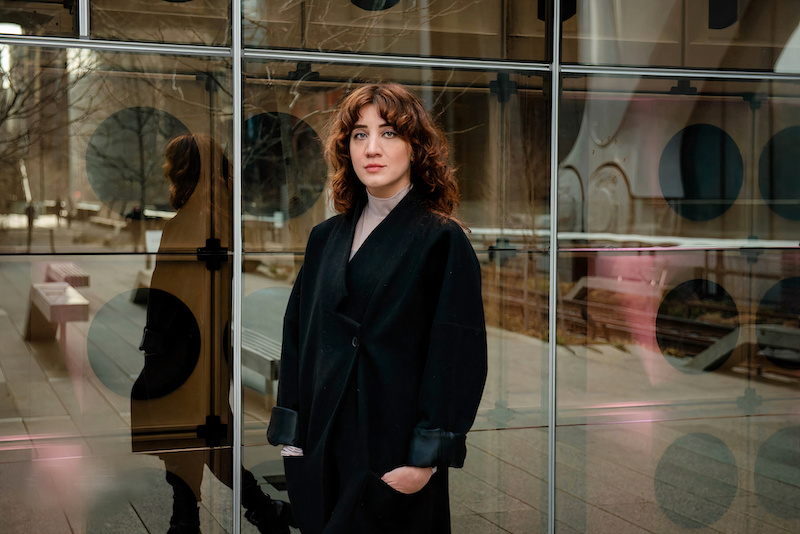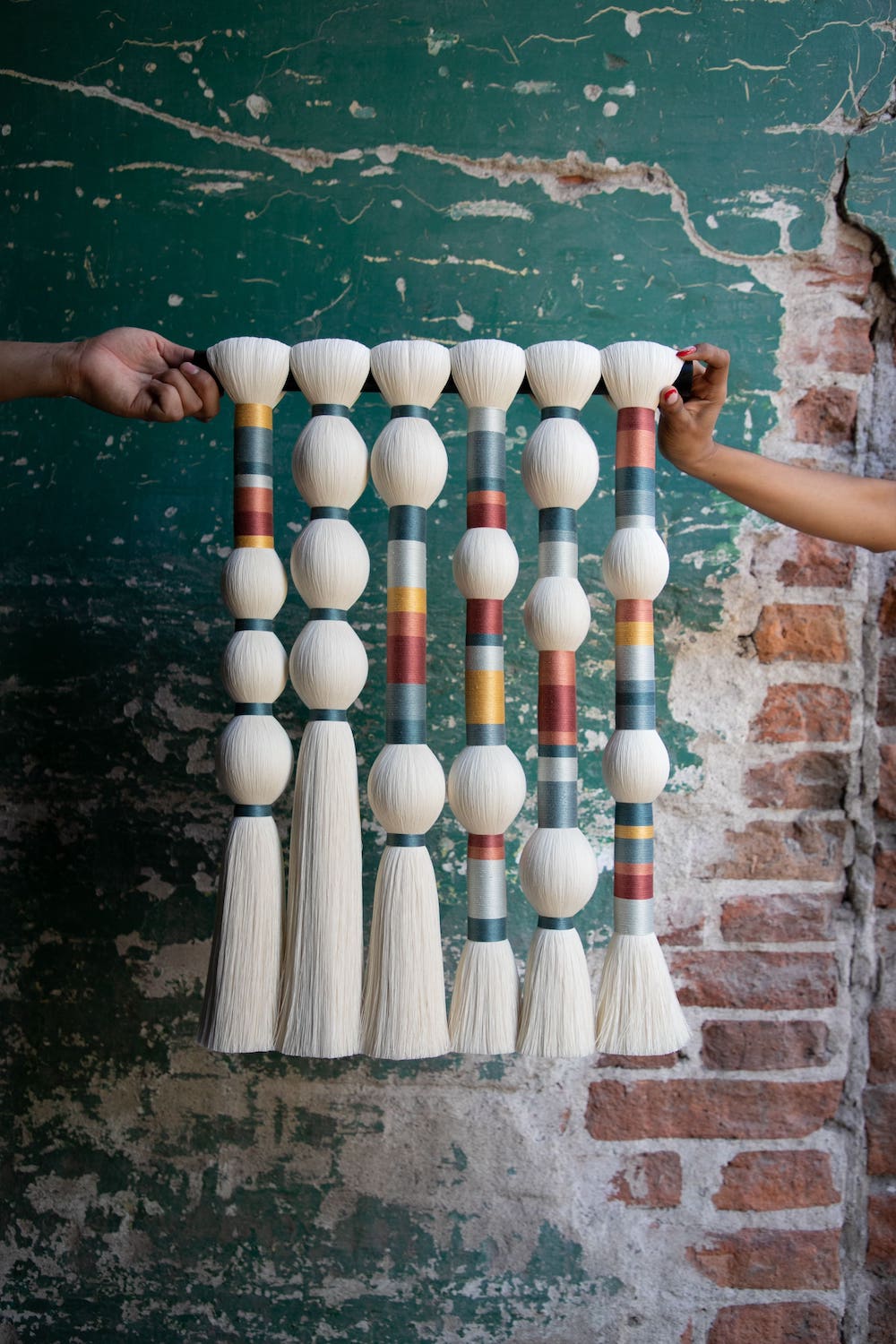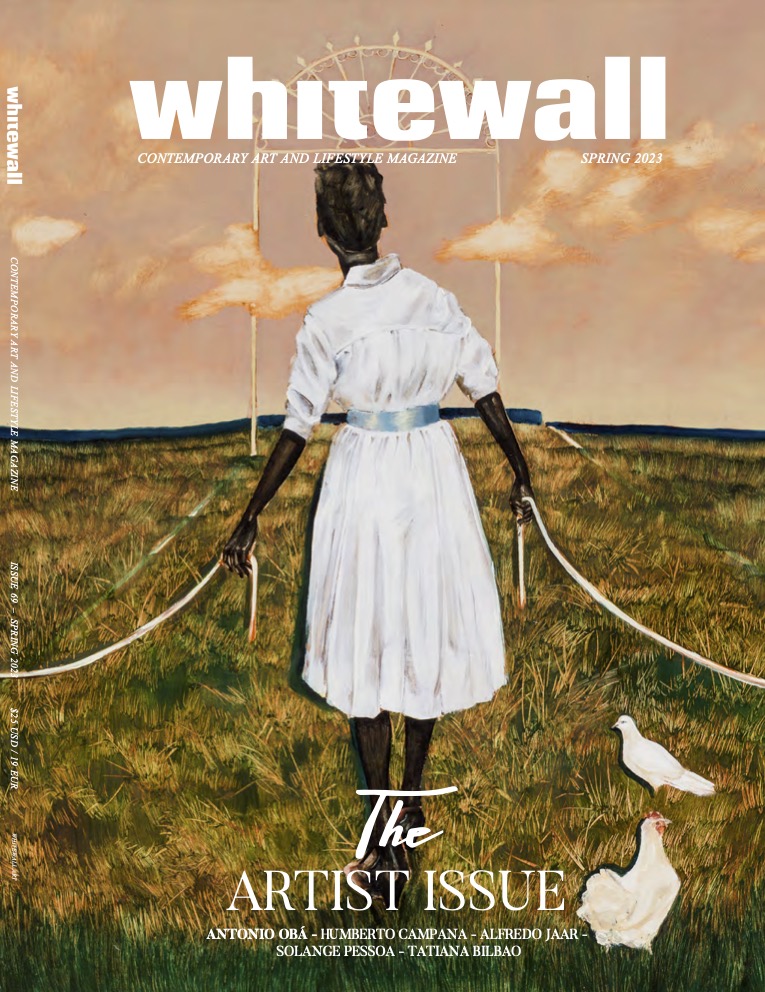Vivian Caccuri Investigates the Impact of Sound on Our Bodies
Vivian Caccuri is interested in how the vibrational waves of sound impact our bodies on a cellular level. What is it about a bass sound wave that makes us dance? How do the natural rhythms inside of us, the thumps from our heart pumping blood and oxygen, connect to the music that moves us? She has created installations that give form to invisible sound waves, with subwoofers stacked high, paired with candelabras whose flames dance to a pulsating beat. They are poetic scientific experiments; they are altars to sound.
Her work was recently on view at the New Museum in New York, in “The Shadow of Spring,” a specially commissioned piece made in collaboration with the artist Miles Greenberg, curated by Bernardo Mosqueira. The project marks the first time she was able to frame one of her embroidered mosquito nets fully with speakers. Scenes of figures in motion, oblong orbs, and circles mirroring drivers quiver against a soundtrack recorded from Caccuri’s own organs. The moiré effect on the mosquito net canvas is reflected in the pools of water at the base of Greenberg’s sculptural fountains.
From her studio in Brazil, Caccuri spoke with Whitewall about the bliss of dissolving into music.
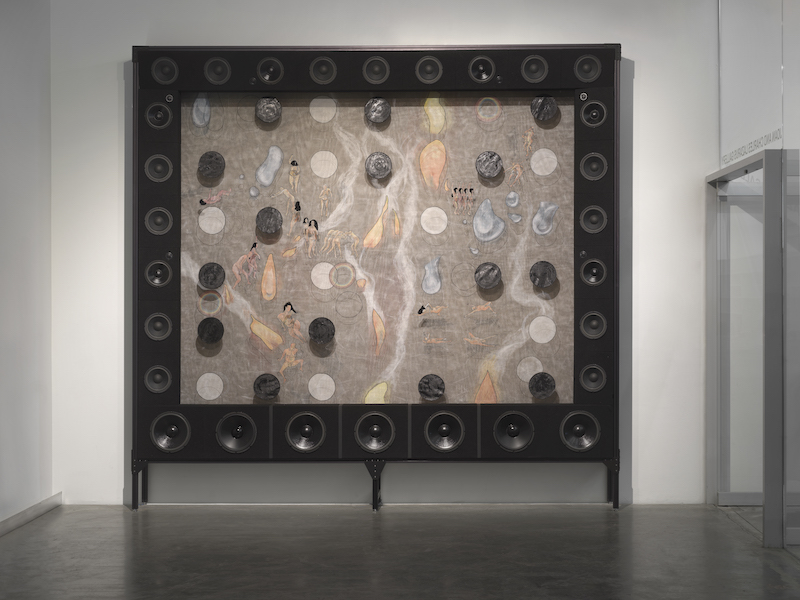
Installation view of “Vivian Caccuri and Miles Greenberg: The Shadow of Spring” (2022) at the New Museum, New York, photo by Dario Lasagni, courtesy of the New Museum.
“It was already a desire of mine to bring sound and embroideries together in one object.”—Vivian Caccuri
WHITEWALL: How were you first approached by the New Museum for what would become “The Shadow of Spring”? How did you work together with Miles Greenberg?
VIVIAN CACCURI: Bernardo came with the invitation. He wanted it to be a dialogue that would go outside Latin American dialogues. I was very enthusiastic about trying to collaborate or coexist with an artist that is New York–based. We have a lot of things in common, me and Bernardo, the curator. But I think party culture was something that we are always paying attention to. So I was and am throwing parties in my studio. I recently moved to a very large space, throwing these parties, inviting people to play DJ performances, and I’ve been photographing these parties and drawing the people, wanting it to relate to the sensations of the party.
That was the starting point for my idea at the New Museum show. It was already a desire of mine to bring sound and embroideries together in one object. I’ve done several shows where I had sound installations but never framing an embroidery with a sound system. These embroideries are made on mosquito screens, and I can paint, embroider, and sew this on them.
Miles and I have been paying attention to the body in this exhibition, how the body transforms itself when there is music involved, when sound is in the space, how music and sound in a space changes absolutely everything, socially speaking. People behave differently, they move differently, they look at each other differently. I had this idea of creating the sound from our own bodies. I recorded gut noise, lung noise, and heartbeats. And from these sound waves, I created the soundtrack. There is something unconventional about the sound. It’s not a party track, and, of course, it shouldn’t be a party track. But there’s something there that I want to explore more in the future.
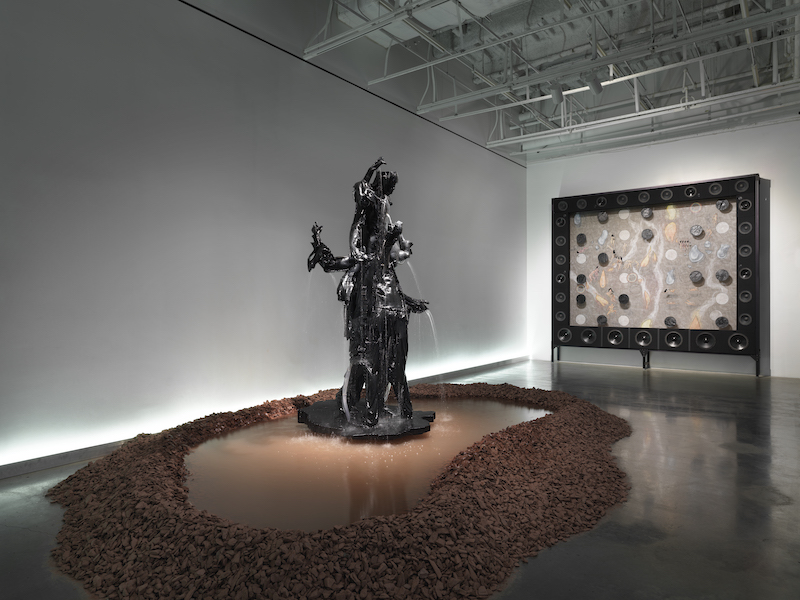
Installation view of “Vivian Caccuri and Miles Greenberg: The Shadow of Spring” (2022) at the New Museum, New York, photo by Dario Lasagni, courtesy of the New Museum.
WW: What kind of relationship do you see between the embroidery, the works on the mosquito net, and sound? Can we see the vibration on the mosquito net?
VC: Definitely. Usually two screens create their own moiré effect. And it’s a vibration that follows your movement when you’re walking toward or across the work. I wanted something that would enhance the sound experience. I really wanted to create something strange and use speakers as frames. Textiles and speakers are in the same universe. There are a lot of textiles that are traditionally applied to speakers, and for me, it was part of something that is familiar but with different dimensions and forms.
I wanted people to really feel this vibration, to really feel this beat. And to make that happen, you need a lot of space. You need a lot of subwoofers. Low-frequency sounds have been in my work for years now. It’s kind of a science that you have to understand and develop, and because it’s very different to work with midrange, high-pitched sounds. Low-frequency sounds literally make the space shake. I wanted to avoid the walls shaking, but I don’t want to lose the sensation. It’s a very interesting alchemy-slash-science.
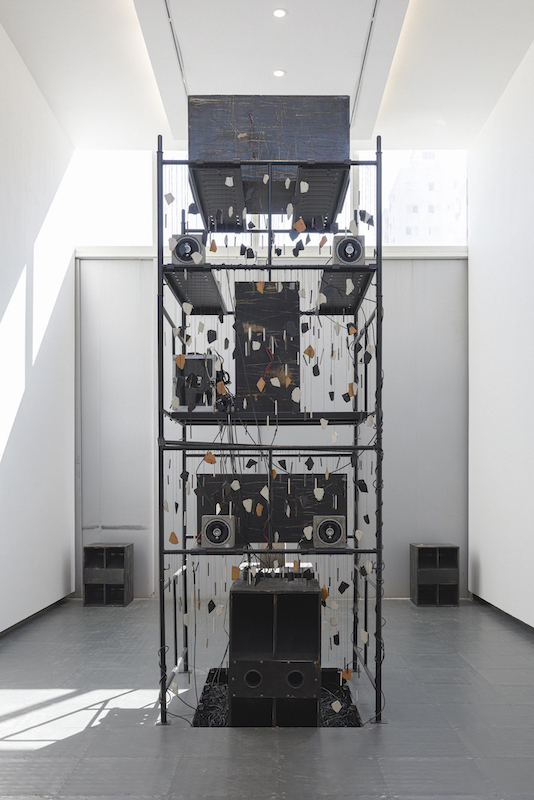
Installation view of the exhibition “Vivian Caccuri: Decompressed” (2022) at Millan, photo by Ana Pigosso, courtesy of the artist and Millan.
WW: So you’re thinking about how the sound affects the space, but also I’m sure you’re thinking about the way it feels in the viewers’ bodies, right?
VC: Yes. There are some sounds that, when you listen to them, you feel they are really going toward your gut, sometimes more over your chest, sometimes your head. Good DJs and good producers usually play with these levels.
It’s not a nightclub, so you can’t and you don’t need to go so loud. You don’t have to blast the sound over the audience. You can be more subtle. And I needed to create silence in the space as well, because you have Miles’s work’s sound, the water is so soothing. And you instigate people to ask for more, because they listen to it and they wait for it to come back. I like creating that kind of narrative as well.
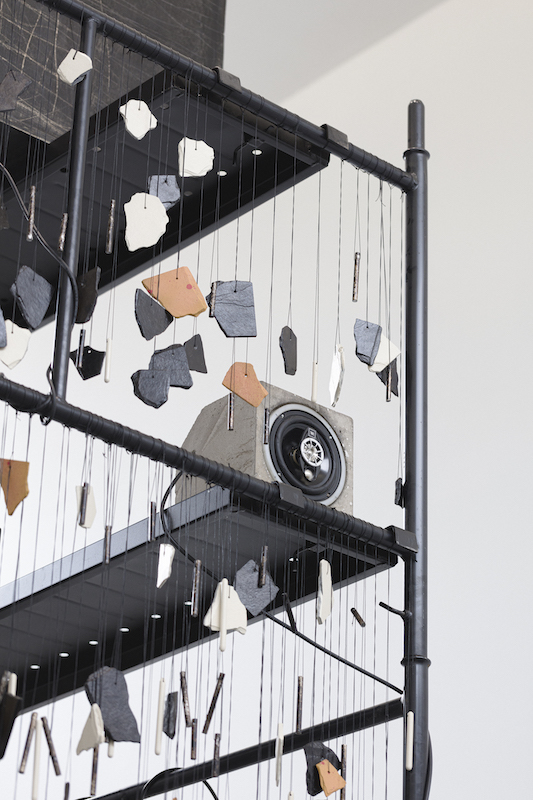
Installation view of the exhibition “Vivian Caccuri: Decompressed” (2022) at Millan, photo by Ana Pigosso, courtesy of the artist and Millan.
Vivian Caccuri’s “Decompressed” at Millan Gallery
WW: Your recent solo show at Millan gallery, “Decompressed,” also addressed party culture. Can you tell us about those works?
VC: “Decompressed” is more for me a personal journey. The two years of the pandemic, and almost one year that we have been in lockdown, have been terrible for everyone’s mental health, including mine. I felt paralyzing anxiety. As soon as I was allowed to throw parties, I started throwing parties out of desperation. I really wanted to feel alive again. To feel butterflies in my stomach again. So all these artworks I created in this experience of feeling life again through the sound, through parties, through meeting people, and watching people dance.
The sound installation has the same method that I used for the museum—it comes from recordings of my own body. But there I felt that I had to use rougher, not so remixed and chopped-up, so you feel that it’s a little bit more raw.
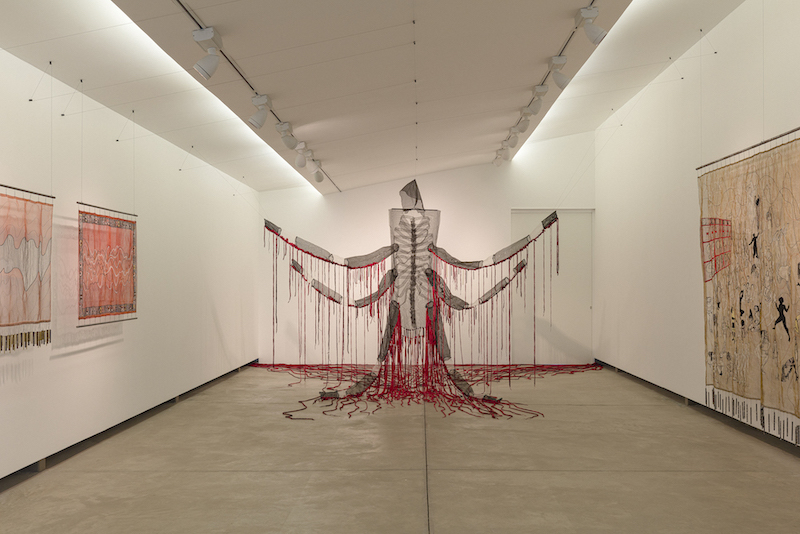
Installation view of the exhibition “Vivian Caccuri: Decompressed” (2022) at Millan, photo by Ana Pigosso, courtesy of the artist and Millan.
Every time I address the party in this show, you have the shadow of the party. The show is divided in two. On the left half you see people dancing, and having a great time, and dissolving themselves into very pleasurable sound waves. On the other side, you have the hangover, and the doubts, and self-doubt, and the frustrations that many parties can bring. You know, parties sometimes can be extremely frustrating, and sometimes you go home worse than you went. It’s not always amazing. I wanted to bring that as well, in a sense, not to be a kind of a downer, but to enhance the experience when the party goes very, very well.
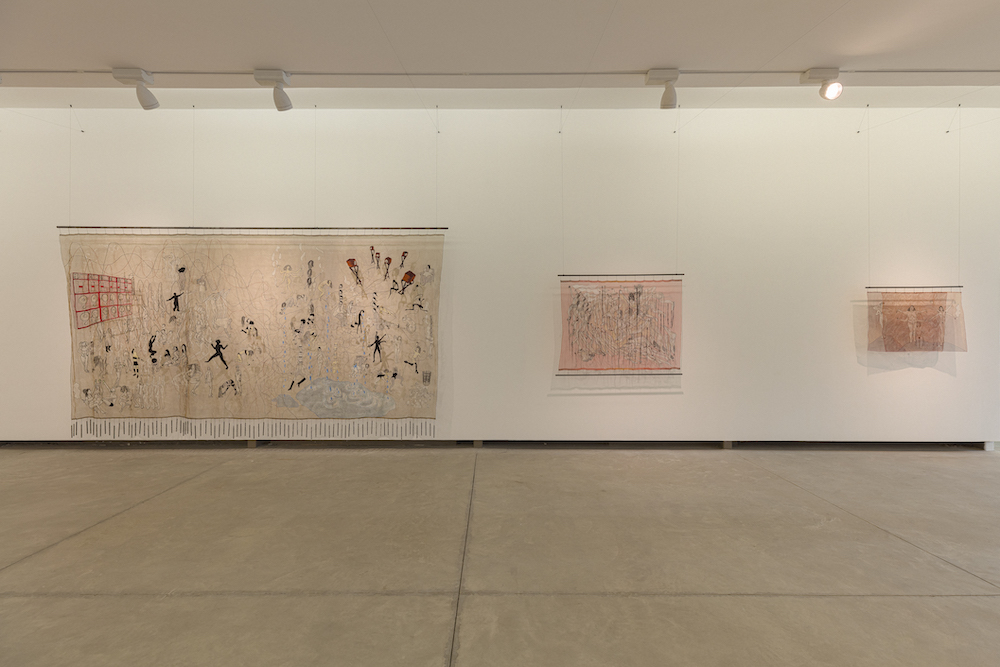
Installation view of the exhibition “Vivian Caccuri: Decompressed” (2022) at Millan, photo by Ana Pigosso, courtesy of the artist and Millan.



